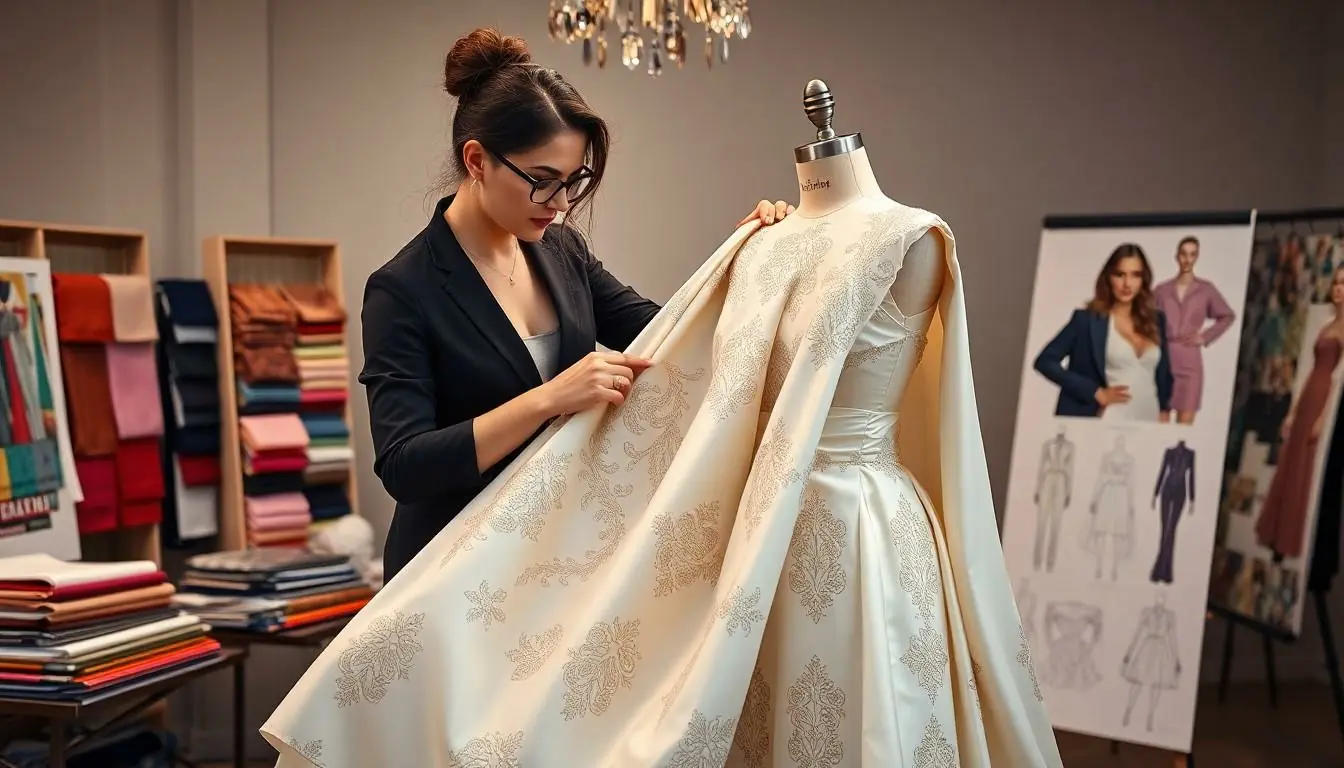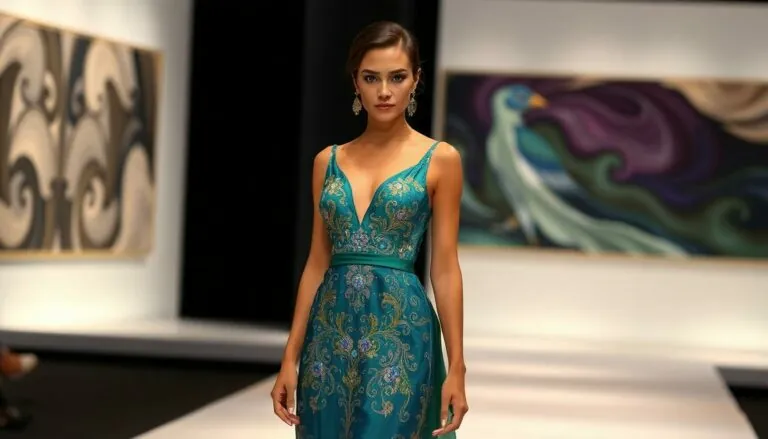In the world of fashion, haute couture designers are the wizards conjuring magic from fabric. These creative geniuses don’t just make clothes; they craft wearable art that leaves jaws on the floor and wallets gasping for air. If you think your favorite T-shirt is a masterpiece, wait until you see a gown that’s literally a work of art—complete with intricate beading and enough drama to star in its own soap opera.
Table of Contents
ToggleOverview of Haute Couture Designers
Haute couture designers represent the pinnacle of fashion craftsmanship and artistry. These individuals create luxurious, custom-fitted garments that often grace runways and elite social events. Each designer brings a unique vision, blending traditional techniques with innovative concepts, resulting in breathtaking collections.
Prominent designers in the haute couture scene include names like Chanel, Dior, and Givenchy. These brands set benchmarks in quality and creativity, showcasing garments that feature intricate embroidery, unique fabrics, and unparalleled attention to detail. Their creations often push the boundaries of fashion, inspiring trends that influence ready-to-wear collections globally.
Designers in haute couture adhere to strict regulations set by the Chambre Syndicale de la Haute Couture. This organization defines the industry standards, ensuring that collections reflect authenticity and excellence. Clients commissioning pieces often engage in a personalized process, with fittings and adjustments tailored to their individual measurements.
Emerging designers also contribute to this elite landscape, breathing fresh ideas into the age-old traditions of haute couture. With an eye for modern aesthetics, they attract a new generation of clientele seeking innovative designs. Creativity remains the heartbeat of this sector, driving designers to explore uncharted territories in fashion.
Fashion houses often present their collections during Paris Haute Couture Week. This event showcases the finest talents, attracting international media attention and fashion connoisseurs. Each show serves as a platform for designers to express their artistic visions while capturing the imaginations of global audiences.
Diversity in styles and influences marks the haute couture world. Designers draw inspiration from various cultures, art movements, and historical references. This rich tapestry of ideas ensures that haute couture remains a vibrant and evolving domain within the fashion industry.
History of Haute Couture

Haute couture has a rich history marked by innovation and artistry. The journey began in the 19th century, specifically with Charles Frederick Worth, often cited as the father of haute couture.
Early Influencers
Charles Frederick Worth established the first haute couture house in Paris during the 1850s. His introduction of the fitted bodice and the use of live models transformed the fashion industry. Worth’s work influenced designers like Paul Poiret and Coco Chanel, who further shaped the landscape with their distinct styles. Paul Poiret popularized the concept of the designer as an artist, moving away from restrictive corsetry. Coco Chanel revolutionized women’s fashion by introducing more comfortable, elegant silhouettes. The contributions of these early influencers set a foundation for haute couture, marrying art with clothing in unprecedented ways.
Evolution of Styles
Haute couture witnessed significant transformations throughout the 20th century. The 1920s marked a shift with flapper styles emphasizing freedom and simplicity, while the 1940s saw Christian Dior’s “New Look” revive femininity with its hourglass shapes. The 1960s introduced avant-garde elements, reflecting social changes and experimentation. Designers like Yves Saint Laurent challenged conventions by incorporating ready-to-wear elements into haute couture, bridging the gap between high fashion and street style. In recent decades, modern influencers infuse technology and sustainability, ensuring haute couture remains relevant. Thus, haute couture continues to evolve, reflecting cultural shifts and innovations in the fashion industry.
Prominent Haute Couture Designers
Haute couture captivates through the work of its prominent designers, who exemplify artistry and technical mastery in fashion.
Iconic Designers
Chanel, Dior, and Givenchy stand as icons in haute couture. These designers redefine elegance through luxurious garments that showcase intricate embroidery and innovative concepts. Chanel’s designs revolutionized women’s fashion by introducing comfortable yet sophisticated silhouettes. Dior’s “New Look” redefined femininity in the 1940s, emphasizing an hourglass shape. Givenchy’s devotion to craftsmanship resulted in timeless pieces for notable figures such as Audrey Hepburn. Each iconic designer transforms fashion into a statement, reflecting cultural shifts and setting industry standards.
Emerging Talents
New voices in haute couture are reshaping the fashion landscape. Designers like Schiaparelli and Rejina Pyo bring fresh ideas and modern aesthetics to the forefront. Schiaparelli explores surrealism through bold colors and unexpected shapes, while Pyo emphasizes sustainable practices without sacrificing style. Each emerging designer seeks to attract a new generation of clientele, blending contemporary themes with traditional craftsmanship. Their innovative approaches not only diversify the haute couture space but also invigorate it with fresh energy and perspective.
The Creative Process Behind Haute Couture
Haute couture designers engage in intricate creative processes to bring their artistic visions to life. They explore various elements, from historical references to contemporary themes, ensuring that each collection resonates with its audience.
Design Inspiration
Design inspiration for haute couture often springs from diverse sources. Nature’s beauty, art movements, and cultural motifs frequently serve as muses for designers. Historical contexts also play a significant role, with many designers revisiting past styles and reinterpreting them for modern audiences. Avant-garde influences, often seen in collections, challenge traditional aesthetics and invite viewers to think differently. Designers like Schiaparelli draw upon surrealism, creating pieces that astonish with bold colors and unexpected forms. Such varied inspirations highlight the versatility and creativity inherent in the haute couture realm.
Tailoring Techniques
Tailoring techniques in haute couture exemplify precision and craftsmanship. Each garment undergoes meticulous construction, often requiring hundreds of hours from skilled artisans. Hand-stitching and draping methods are commonly employed to achieve perfect fits. Techniques such as boning and under-structuring add shape and form to garments, enhancing their elegance. Localized craftsmanship meets global influences, creating unique styles that set trends. Following traditions while integrating innovative processes, haute couture remains at the forefront of fashion evolution. Each piece reflects an intricate blend of artistry and technical skill, signifying the commitment to excellence within the industry.
Impact of Haute Couture on Fashion Industry
Haute couture influences the fashion industry significantly, shaping trends, cultural narratives, and economic frameworks.
Cultural Significance
Haute couture embodies cultural narratives, acting as a canvas for artistic expression. Designers reflect social movements and cultural shifts through their collections, often addressing themes like feminism, identity, and innovation. Collections often draw inspiration from a range of influences, including global art forms, traditional craftsmanship, and historical references. Notable designers, such as Alexander McQueen and Jean Paul Gaultier, challenge conventions and provoke discussions, with their eccentric designs sparking conversation about beauty standards and self-expression. This cultural dialogue often elevates haute couture from mere fashion to a form of visual art that resonates with societal values.
Economic Contributions
Haute couture contributes substantially to the global fashion economy. Each collection showcases luxury craftsmanship, attracting affluent clients who appreciate exclusivity. A single haute couture piece can command prices that range from tens of thousands to millions of dollars, reflecting the value of bespoke artistry. Events like Paris Haute Couture Week generate billions in revenue through tourism, media engagement, and retail partnerships. Besides Direct sales, haute couture supports countless industries, from textiles to artisans who produce garments. The sector plays a crucial role in establishing brand prestige for fashion houses, driving wider economic impact and growth.
Haute couture designers embody the essence of luxury and creativity in fashion. Their unique ability to blend tradition with innovation results in breathtaking garments that not only adorn but also tell stories. As they continue to push boundaries and redefine standards, these designers ensure that haute couture remains a dynamic and influential force in the fashion industry. With each collection, they inspire and provoke thought, making their mark on cultural narratives and artistic expression. The future of haute couture looks promising as emerging talents breathe new life into this prestigious realm, ensuring its evolution and relevance for generations to come.





